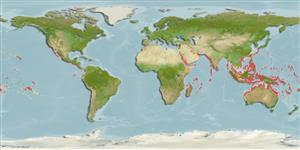Common names from other countries
>
Gobiiformes (Gobies) >
Gobiidae (Gobies) > Gobiinae
Etymology: Asterropteryx: Greek, a = with + Greek, sterros, -a, -on = consistent + Greek, pteryx = fin (Ref. 45335).
More on author: Rüppell.
Environment: milieu / climate zone / depth range / distribution range
Écologie
marin récifal; profondeur 1 - 20 m (Ref. 9710). Tropical; 30°N - 32°S
Indo-Pacific: Persian Gulf (Ref.80050) and Red Sea to the Hawaiian, Line, and Tuamoto Islands, north to southern Japan, south to Lord Howe and Rapa.
Taille / Poids / Âge
Maturity: Lm ? range ? - ? cm
Max length : 6.5 cm TL mâle / non sexé; (Ref. 11344)
Description synthétique
Clés d'identification | Morphologie | Morphométrie
Épines dorsales (Total) : 7; Rayons mous dorsaux (Total) : 9 - 11; Épines anales: 1; Rayons mous anaux: 8 - 9. Body tan to black in color with light spots; midside with small elongate dark spots; short vertical bars or saddles above (Ref. 2798); characterized further by prolonged third dorsal spine , forms long filament in adult; longitudinal scale series 23-25; ctenoid scales; head scaled except snout and interorbital space; 3-9 close-set spines on edge of preopercle just above the corner; rounded caudal fin; depth of body 3.0-3.6 in SL (Ref. 90102).
Found on algal-coated reef rock and rubble of inner flats and turbid lagoons (Ref. 1602). Takes refuge in burrows or holes in the reef (Ref. 11441). Benthic (Ref. 58302). Feeds on small benthic invertebrates (Ref. 89972). Solitary or in small group (Ref 90102).
Life cycle and mating behavior
Maturities | Reproduction | Spawnings | Egg(s) | Fecundities | Larves
Benthic spawner.
Myers, R.F., 1991. Micronesian reef fishes. Second Ed. Coral Graphics, Barrigada, Guam. 298 p. (Ref. 1602)
Statut dans la liste rouge de l'IUCN (Ref. 130435)
CITES (Ref. 128078)
Not Evaluated
Menace pour l'homme
Harmless
Utilisations par l'homme
Pêcheries: commercial; Aquarium: Commercial
Outils
Articles particuliers
Télécharger en XML
Sources Internet
Estimates based on models
Preferred temperature (Ref.
115969): 24.7 - 29.3, mean 28.2 (based on 3295 cells).
Phylogenetic diversity index (Ref.
82804): PD
50 = 0.5039 [Uniqueness, from 0.5 = low to 2.0 = high].
Bayesian length-weight: a=0.01000 (0.00601 - 0.01665), b=3.17 (3.03 - 3.31), in cm Total Length, based on LWR estimates for this species & (Sub)family-body (Ref.
93245).
Niveau trophique (Ref.
69278): 2.4 ±0.00 se; based on food items.
Résilience (Ref.
120179): Haut, temps minimum de doublement de population inférieur à 15 mois (Preliminary K or Fecundity.).
Fishing Vulnerability (Ref.
59153): Low vulnerability (10 of 100).
